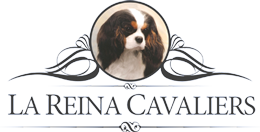FOOD:
We feed Eukanuba Puppy Small Breed, but otherwise, do not change brands before your puppy is a year old. We feed our puppies morning and night, while some breeders recommend leaving a crock of food available at all times. If you feel the puppy is stressed and not eating, you may entice him/her with some grilled chicken of canned puppy food. Do NOT give your puppy milk, red meat of any kind or any fried foods.
DISHES:
We recommend 2 heavy 16 oz. ceramic crocks (available at PetSmart). One for water and the other for dry food.
BEDDING:
Puppies like donut beds, and it’s a good idea to have more than one (so they can be washed). Our dogs eat and sleep in crates, but otherwise, they spend their time in the shaded backyard and in the house with us. Cavaliers are people-dogs, and prefer to be with you at all times.
A #200 series Vari-Kennel will prove useful for trips to the vet and training class. It is not for use all day, every day. Crated dogs are prone to urinary/kidney infections from having to wait long periods of time to go out to potty.
Wire crates allow more air to circulate, and the dogs can see out of them more. However, they are cumbersome to carry to and from the car. Even the very large one are unsuitable for housing a dog, as they are directly on the ground, which is too cold for a Cavalier.
PLAYPENS:
You can order a 36″ x 36″ puppy playpen (with hygenic floors, pans and lid to avoid escaping) from www.centralmetalproducts.com or www.petedge.com . This, rather than a crate, can be where puppy eats and sleeps and will be big enough for the rest of the dog’s life. It keeps them off the floor, where it’s cold and out of trouble.
It’s very handy to have an outside, portable exercise pen for baby to play and potty in. These vary in size, but a 6-8 panel should suffice. These clip together on both ends and can be taken on trips for roadside stops.
HOUSEBREAKING:
Our Cavaliers use a doggy-dog. While this may not be feasible for everyone, it’s a tremendous advantage to you. Your new puppy already has the idea of keeping his/her den clean and to potty elsewhere. You can easily build on this by taking baby out frequently to the potty area you’ve chosen. the most important times are first thing in the mornining, again in an hour after eating breakfast, and every two hours after that, then once more the last thing before bedtime. Babies go more frequently than adults, who only need to go out 3-4 times a day.
If you’re lucky enough to have a dog door, surround it with a small portable ex-pen, so puppy will have to use it. Make it big enough for her water, food and toys. Be sure puppy’s outdoor area is secured with a dog run or fence.
Above all, be patient when it comes to housebreaking your Cavalier baby.
HAIR CARE:
www.petedge.com is a good source of high quality shampoos and conditioners. You’ll also find soft slicker brushes to straighten ears, back coat and feathers on legs and tail (adult dogs only), steel combs for the ears and feathers and soft brushes for sensitive areas – legs and head (only use a soft brush on puppies i.e. Mason Pearson or #1 All Systems Natural Boar Brush.) We recommend a snood to keep ears out of their food (otherwise, they’ll be snacking on their ears later). Bathe your Cavalier as often as you wish. A weekly bath is best. We use EZ Groom Crystal White Enzyme Shampoo from www.showdogstore.com. It’s kind of expensive, but really gets the whites white and doesn’t require a conditioner.
If you ever plan to compete your dog at shows, do NOT cut any of the dog’s hair whatsoever. A judge who detects any scissoring can disqualify you. Only the hair between the pads of their feet can be cut.
A grooming table with an arm and noose will prove invaluable…but a rug on your washing machine will do in a pinch. But never leave a puppy or adult dog unattended while on a grooming table or any raised object.
TOYS:
Cavaliers love soft latex squeaky toys, and milk bones. Our vet says there’s a danger of choking with rawhide and greenies. Booda bones (rope toys) are good chew toys. Never give a dog chicken or pork bones.
COLLARS AND LEADS:
Collars are great for puppies as they accustom them to future leash training. fow show dogs, take care that the collar isn’t wearing off any hair around the neck or throat areas. It’s a good idea to have an ID tag on the collar with your name and phone number. We recommend micro-chipping of your puppy. We like Resco leashes with a slide for training and showing. For walks around the neighborhood, a leash that snaps to your dog’s collar is good. Make sure you can get two fingers between your dog’s collar and neck. Any more than that and it’s too loose, and less than that is too tight.
